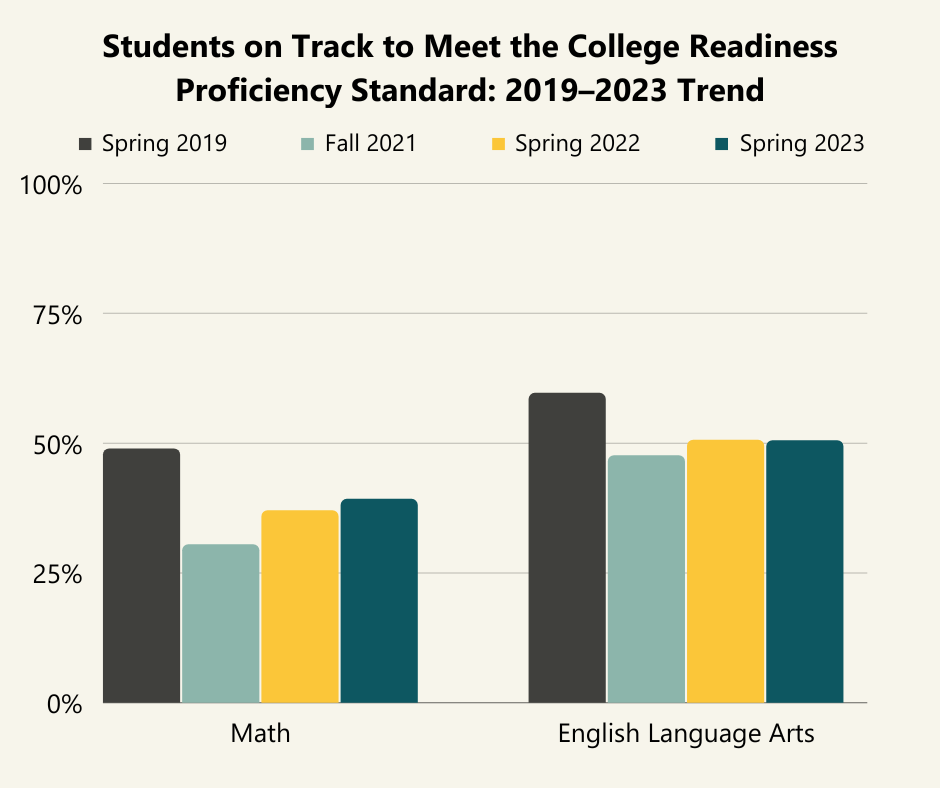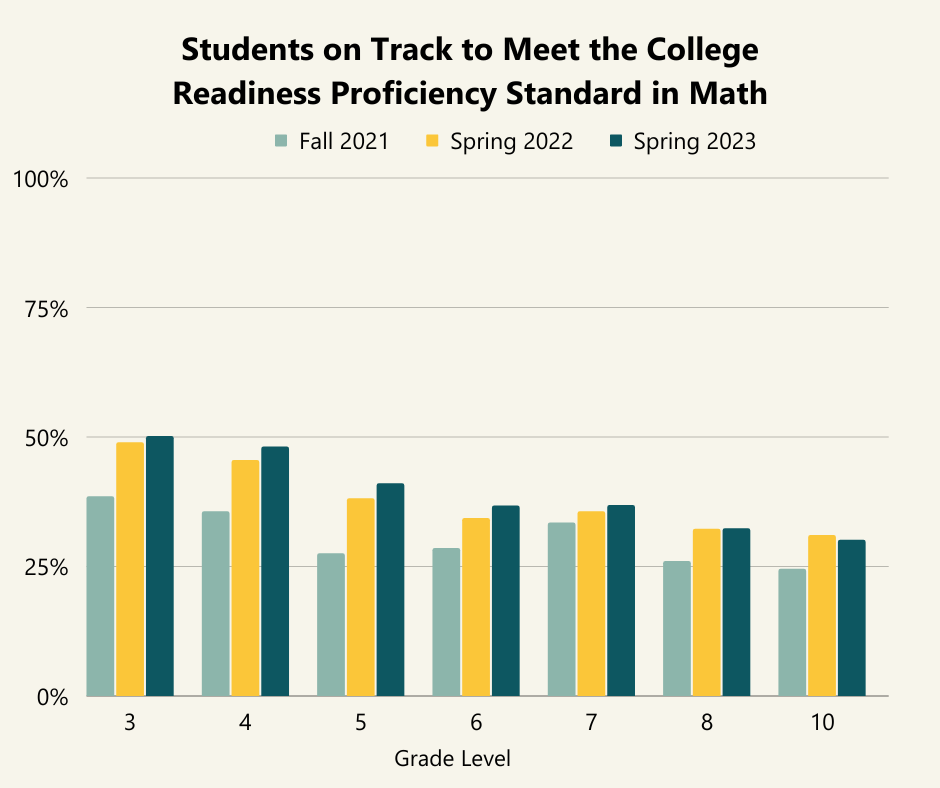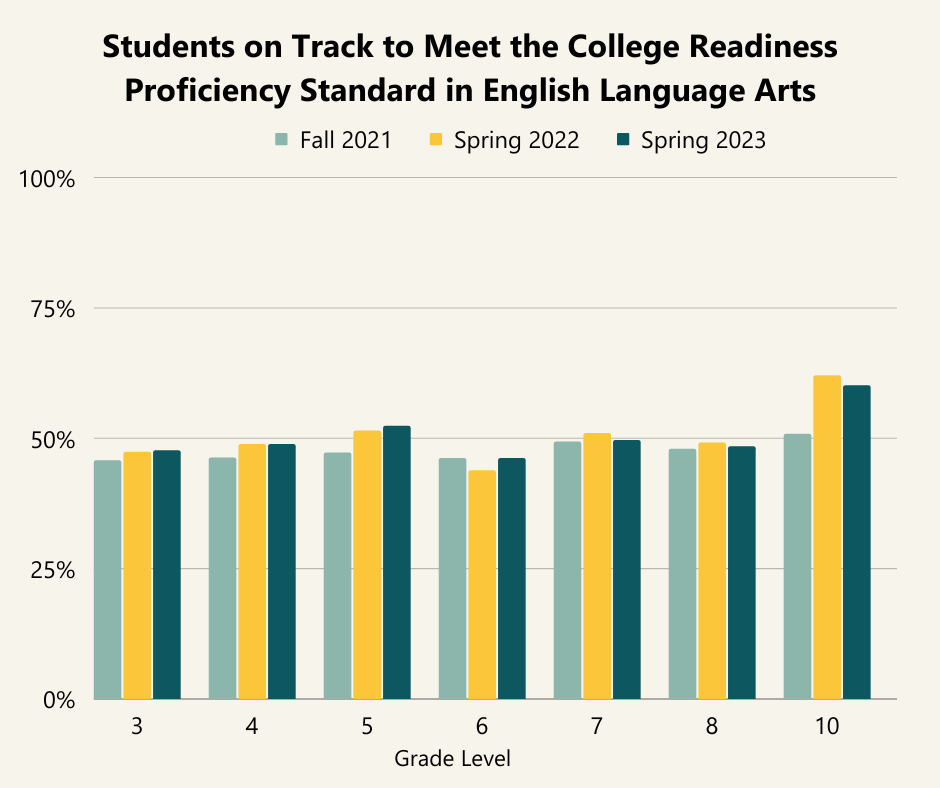|
OLYMPIA — September 8, 2023 —Today, the Office of Superintendent of Public Instruction (OSPI) released data from the spring 2023 state assessments, which are one indicator of continued pandemic learning recovery. Overall, the data indicate accelerated learning recovery in math in nearly all grades assessed, as well as in English language arts at the elementary level.
The tests, offered each spring to students in grades 3–8 and 10, are one way of assessing the depth of each student’s knowledge and abilities in math and English language arts. Even in the earlier grades, the tests are designed to measure whether a student is on track for college-level learning without needing remedial classes.
For example, in assessing reading and comprehension ability in the third grade, a lower score indicates that the student was able to identify central ideas in texts of low or moderate complexity and distinguish between literal and non-literal meanings of words and phrases. On the same assessment, a higher score indicates that the student could identify explicit evidence or supporting details to support basic inferences in text of moderate-to-high or unusually high complexity.
Families, policymakers, and community members should be cautious about viewing state assessment scores as the primary indicator of student learning and growth. Engagement, attendance, grades, and classroom-based assignments and tests provide more detailed, timely, and useful information about individual students' progress to their families and educators.
“Our students enter our school buildings each day and add new learning and skills to their toolbelt,” said State Superintendent Chris Reykdal. “Each and every student is learning year over year! Smarter Balanced Assessments are not pass/fail tests. The tests are designed to measure college readiness without needing remedial learning. To use these data to describe students or schools as ‘failing,’ as some do, is misleading and irresponsible.”
Washington students continue to perform similar to or better than students enrolled in public schools across the U.S. on the National Assessment of Educational Progress (NAEP), the nation’s only assessment where statistically sound comparisons between states can be drawn. NAEP data continue to show that Washington’s students make gains in both math and English language arts over time. The data also place Washington’s eighth graders in the top 15 states in the country for their math and reading abilities.
As one way of assessing student learning recovery, the Office of Superintendent of Public Instruction (OSPI) monitors student growth and learning acceleration, as displayed in the chart below. The two bars indicate student progress from the 2022 to the 2023 assessments.
 Note: Data on students who made progress on state assessments from 2022 to 2023 are available at the state level only.
Under federal law, each state is required to administer statewide assessments in grades 3–8 and once in high school. At a system level, the data are used to identify opportunity gaps and influence investments and policy priorities to support student learning. As required by federal law, assessment data inform the level of support the state provides to each school through the Washington School Improvement Framework.
“Some of our students face persistent opportunity gaps which continue to be reflected in these data,” Reykdal said. “Our schools, community partners, and the state get better each year at targeting resources to the students who would benefit from additional supports, and in many communities, they are seeing their efforts make a difference.”
For both math and English language arts, the 2023 data show opportunity gaps for students with disabilities; multilingual/English learners; students experiencing homelessness; students identified as low-income; and students who identify as American Indian/Alaskan Native, Native Hawaiian/Other Pacific Islander, Hispanic/Latino, and Black/African American.
Trends in the Data Over Time
At the height of the COVID-19 pandemic in fall 2021, assessment scores in Washington dropped by several percentage points, mirroring the declines across the nation. While test scores are not yet back to what they were pre-pandemic, scores in 2022 and 2023 are evidence of the diligent recovery and acceleration efforts by Washington’s students, educators, and families.
 Note: Fall 2021 tests were not typical in their timing and length but give an indication of student learning and progress.
The two figures below show the recovery taking place by grade since the fall 2021 test. The data come from the Smarter Balanced Assessment (SBA), as well as from the Washington Access to Instruction and Measurement (WA-AIM) alternate assessments for students in grades 3–8 and 10 with significant cognitive disabilities.

 The data show evidence of student learning recovery at all grade levels, with the strongest recovery in math. (It should be noted that math saw the largest decrease during the pandemic.) In addition, while 10th grade scores declined from 2022 to 2023 in both math and English language arts, student participation levels in that grade also decreased. This is likely a result of a growing percentage of students choosing a graduation pathway that allows them to earn a diploma through dual credit course completion––earning college credit while in high school––instead of assessments.
Finally, it should be noted that the Smarter Balanced assessment aims to measure student ability in one year compared to students at that grade level from the previous year. The assessment is not designed to measure a single student’s ability and readiness over time. Over the next year, OSPI will explore options for more adequately balancing the assessment of cohort progress with individual student progress.
Viewing Assessment Results
Assessment results for math, English language arts, and science are available for the state as well as by school and school district on the Washington State Report Card. Users can also download data files from the Report Card if they are interested in more detail.
Parents and families should contact their child's school or school district for more information about their student's assessment results.
|